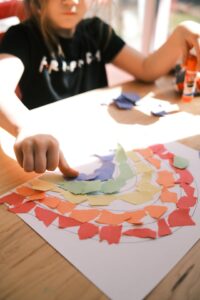
Table of Contents
Children with autism often struggle in their personal, social, and educational environments. As a parent, it may not always be easy to know how to help and support them so as to promote the best possible behaviors and discourage the negative ones.
In this guide, we will look at how to design a Behavior Support Plan, what applied behavioral therapy is, and what kind of professional help you should seek for your child.
What is a Behavior Support Plan
A Behavior Support Plan is a personalized plan designed to help, support, and promote healthy and positive behaviors in a person’s life who may be struggling with challenging behavior. The design of the plan is done to center the participant’s needs and health.
why would a child be given a BSP?
A child may be given a BSP when they are displaying challenging behaviors that are interfering with their ability to learn, communicate, or participate in daily activities. These behaviors may include aggression, self-injury, tantrums, noncompliance, and other disruptive behaviors. The BSP outlines specific strategies and interventions that can be used to help the child manage their behavior more effectively.
The goal of a BSP is to provide the child with the support and skills they need to be successful in their environment. The plan may include a range of interventions such as teaching alternative behaviors, modifying the environment, providing visual supports, and using positive reinforcement.
Overall, a BSP is a critical component of a comprehensive behavior support plan for children with challenging behaviors, as it provides a roadmap for parents, teachers, and other professionals to help the child manage their behavior and achieve success in their daily lives.
Steps of a Behavior Support Plan
A Behavior Support Plan (BSP) is designed to help provide extra, personalized support for a child or student. These plans take into account the child’s difficulties, their homes and learning environments, and other needs the child may have. Let’s consider different aspects of creating the best possible BSP for your autistic child.
Functional Behavior Assessment (FBA)
According to the PACER Center for children with disabilities, a Functional Behavior Assessment (FBA) is “a process for identifying problem behaviors and developing interventions to improve or eliminate those behaviors.” The process takes into account the particular difficulties a child with autism may have in terms of learning, communication, and completing day-to-day tasks.
There are different instances in which an FBA is required for a child such as:
- “[A] child “is removed from school for more than 10 consecutive days for behavior that is a manifestation of the student’s disability.”
- “[A] child is removed for more than 10 school days for conduct that is not a manifestation of the disability but the IEP team determines that an FBA is necessary.
- “[A] child is placed in an interim alternative educational setting for not more than 45 school days for behavior involving a dangerous weapon, illegal drugs or infliction of serious bodily injury.”
Building a Behavior Support Team
According to the Wyoming Department of Health, it is crucial for the behavior support team to be made up “of individuals who play an active role in the participant’s life” and who can work together to improve behaviors. This may include:
- Teachers
- Parents
- Friends
- Case Manager
- Psychologist
- Medical Staff
- Program Supervisor
It is important that the people involved in the support team have had significant interaction with the participant so they can best identify the specific struggles they have. This is also why having a diversity of people involved in the team can be useful: teachers may have a better idea of the social struggles the participant may face, while parents may have a better idea of their struggles with daily tasks.
It is also crucial for the people involved in the team to be able to communicate in a respectful and open manner, and keep the participant’s wellbeing as the goal of the group. Remember, the goal of the group “is to create a team that represents all of the key individuals that will interact with the participant both in and outside of your program.” The team has a responsibility to create a supportive space and network for the individual.
Person Centered Planning (PCP)
According to PACER, Person Centered Planning (PCP) refers to “groups of people focus on an individual and that person’s vision of what they would like to do in the future.” The idea with PCP is to create a space where the behavioral support team can come together to help develop a plan to help the person gain autonomy over their life in a safe and productive way.
One advantage of Person Centered Planning is that it is creative and adapts to the person involved in the plan. If the participant is feeling unsure about someone in their team, a specific step which is being implemented, or about the direction the plan is taking, Person Centered Planning allows for them to be vocal about these issues and for the plan and the team to adapt accordingly.
What Should Person Centered Planning for Children Look Like?
Ideally Person Centered Planning design should focus on the following:
- Keeping the child at the center of decisions and planning
- Celebrating the child’s successes and accomplishments
- Help the child learn to best express their desires and needs
- Show the child that they are respected and deserve to be
- Help the behavioral support team listen to the child
How is Person Centered Planning Different From Other Kinds of Planning
What Person Centered Planning provides in particular against other forms of conventional planning is that it considers the person as a multifaceted individual with different environments, social conditions, and personality traits. It considers what the particular individual needs given their conditions rather than merely applying generic, pre-designed plans on the person.
Steps for an Person Centered Plan
There are certain steps which should be taken into account when implementing Person Centered Planning. These steps include:
- assessing a child’s current skills and difficulties
- setting goals and objectives – for example, learning how to say ‘hello’
- designing and implementing a program that teaches the ‘target’ skill
- measuring the ‘target’ skill to see whether the program is working
- evaluating the program itself and making changes as needed.
These are steps which can provide effective and adaptive changes to your child’s behavior. As with all therapy, Applied Behavioral Analysis is a process, and requires time to take effect.
What is included in a Behavior Support Plan?
The specific components of a BSP can vary depending on the child’s individual needs and the results of the Functional Behavior Assessment (FBA). However, a typical BSP may include the following elements:
- Summary of the challenging behavior: A description of the behavior(s) of concern, including frequency, duration, and intensity.
- Antecedent strategies: Strategies for preventing or reducing the occurrence of the behavior(s) of concern by modifying the environment, routines, or interactions with others.
- Replacement behaviors: A description of the replacement behaviors that the child can use instead of engaging in the behavior(s) of concern. These behaviors should be functional, socially appropriate, and meet the child’s needs.
- Consequence strategies: Strategies for responding to the behavior(s) of concern, including positive reinforcement for appropriate behavior and consequences for inappropriate behavior.
- Crisis management plan: A plan for managing crisis situations that may arise when the behavior(s) of concern occur.
- Data collection and monitoring: A plan for collecting data on the behavior(s) of concern and monitoring the effectiveness of the BSP over time.
- Training and support: A plan for training parents, teachers, and other professionals on the implementation of the BSP and providing ongoing support to ensure its effectiveness.
Monitoring Behavior Support Plans
The proper monitoring of the behavioral support plan is just as crucial as the implantation of a Behavior Support Plan. This ensures that it is providing the most effective support possible.
To do so, it is important to monitor both the achievements and the problems which may emerge throughout the course of the plan implementation. Monitoring achievements means observing what behaviors the child is best performing and what kinds of situations they best respond to. In that way, the child can be rewarded and appreciated for their work, and encourage them to continue the positive behavior.
It is important for the participant to feel that they are making progress themselves, and that the hard work they are putting into changing their behaviors is acknowledged by the people surrounding them.
Monitoring problems means considering what kind of difficulties arise in the child’s behavior whether those be social, educational, or in their day-to-day life. This is where communication between the team members is crucial so they can touch base about the different issues the child may be having and change or adapt the plan accordingly.
Tips for Behavior Support Plans
There are certain things which are important to keep in mind when creating a Behavior Support Plan. In this section, we will be going over some tips and advice for anyone looking to create a Behavior Support Plan.
Keep Behavior Support Plans Simple
Keeping Behavior Support Plans simple is important so that the goals are clear and transparent. Overcomplicating the plan’s design can sometimes make it more difficult to know exactly what to do or at which part of the process the participant is.
Adjust the Plan When Necessary
While sticking to the plan is in most cases the right way to go, it is crucial to allow for flexibility and the possibility to change and adapt to obstacles and events that may come up. This includes staying attentive to changes in the participant’s desires or needs which may change over time. This may include changing the time frame of the plan if the participant is pacing faster or slower than expected.
Stay Focused on Specific Behaviors
Behavioral therapy is designed on focusing on specific behaviors and behavioral cycles in the participant, and changing those which are negative or causing challenges in their lives. If new negative behaviors develop, it is important to adapt the plan to have those behaviors accounted for.
Keep the Environment Supportive
Therapy is not always easy for either the participant or their support team. Keeping an open communication both about how the plan is going, as well as for the participant to communicate about their feelings regarding the evolution of the plan. This also means regularly checking in with the participant to make sure they feel safe, respected, and supported.
What is Golden Care Therapy?
Golden Care Therapy is a New Jersey-based ABA therapy provider that helps children with autism through Applied Behavior Analysis (ABA) therapy. This center designs personalized treatment for the child as well as Parent Training to help parents support their autistic child.
If you are a New York, New Jersey or Indiana resident looking for high-quality and professional therapeutic support for your autistic child, we recommend Golden Care Therapy.
What Golden Care Therapy Does to Help
Golden Care Therapy uses ABA therapy to best help the child involved and their parents reach their goals in a sustainable way. Its personalized design helps account for all of the different aspects of the child’s life which may require adaptation to ensure success. The focuses of Golden Care Therapy’s program include:
- Language Skills
- Skills Acquisition
- Behavior Modification
- Activities of Daily Life (ADL) Skills
- Social Skills
- Executive Function
Golden Care Therapy also offers Social Skills Groups designed to help children with autism practice social skills in a safe and supervised environment. This is a great way for your child to put into practice the skills they acquire during one-on-one therapy in a fun way.
How Does the Golden Care Therapy Process Work?
If you are a parent looking for quality therapy for your child with autism, Golden Care Therapy has made the process especially easy to access the help you need. The Golden Care Therapy website has outlined the simple steps you will take once you decide to seek professional help.
-
Inquiry
The first step of the process is to either call Golden Care Therapy or fill out one of the online forms which can be found here.
-
Assessment
The second step is to send in insurance information and the formal diagnosis of the child. Once received, the clinical director will meet with your child and yourself for evaluation and to establish the specific therapeutic needs.
-
Approval
Once the assessment has been done, a report will be written out by one of the members of the Golden Care Therapy team which will then be submitted to your insurance. After receiving the insurance’s approval, the child will be able to begin the therapy.
The final steps will be setting up a schedule to best fit you and your child’s personal agendas.
If you are ready to work with the best ABA therapy provider in New York, New Jersey or Indiana, give us a call at (732) 402-0297. Our dedicated team is ready to help and we will treat you like family.
- Autism Routine Disruption in Adults: Coping Tips - July 16, 2024
- Autism and Obsession: An Overview - July 16, 2024
- Autism and Taking Clothes Off: Management Tips - July 16, 2024


